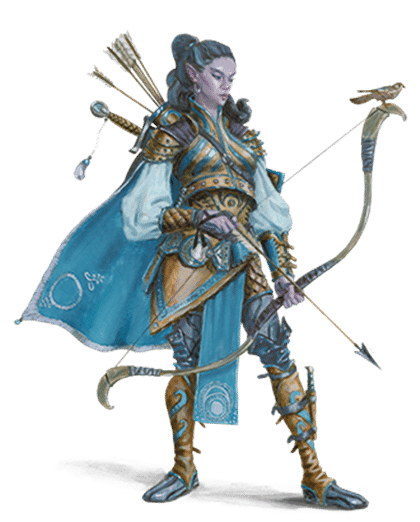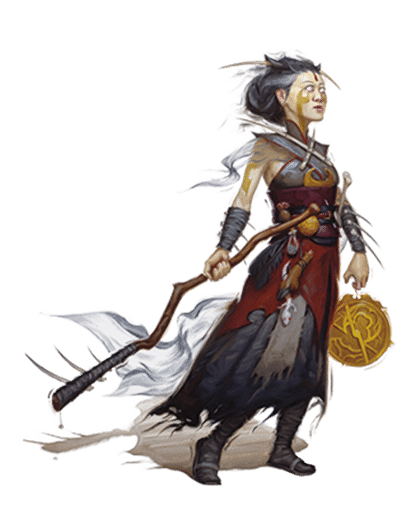Maybe a decade ago I was flipping through the channels and a show caught my eye. A woman had won a $5,000 shopping spree in a large department store. She was poised at the front of the store with an empty shopping cart and 5 minutes to load up whatever she wanted.
But when the starting gun fired, she froze, frantically looking back and forth between all the aisles. She didn’t know what to choose first. The whole thing was just too good. There were just too many options available to her.
Good D&D combat is quick and energetic, ending with hoots, hollers, and fists pumping in the air. But new players can freeze, their turns spent looking back and forth over their character sheets to figure out an action to take.
Here’s the secret: although the wonderful thing about D&D is that your character can do almost anything, the reality is a couple combat actions are what you’ll use over and over, particularly when you are just starting out.
A D&D player, even if they are brand new to the game, can have an index card with 2-3 actions that will work well 75% of the time. So, let’s learn about these “typical” combat decisions for each D&D class, shall we? We’ll be looking specifically at the Ranger, Monk, and Warlock.
But, first, a quick tip on movement. Make the bad guys come to you. Each turn you get to move and take an action. Some folks get so excited for combat that they move toward the enemy, then use their action to move again, taking what becomes a double move.
A double move is nice because of the obvious benefit of getting to move further. But there is no attack action after that; you don’t get to swing your sword after the double move. So don’t double move in order rush to get into a foe’s face. Attack actions are precious. Make foes squander theirs by rushing toward you, while you wait to whack them.
Now, some class-specific attack actions:
 Ranger: Who here is my sworn enemy?
Ranger: Who here is my sworn enemy?

A Ranger is is the skilled tracker, hunter, and woodsman of D&D. They often put these skills to use against a certain type of foe. So, a player new to the Ranger class should enter into combat with the mindset of, “Who here is my sworn enemy?”
Movement: Many Rangers are archers, so use your movement to stay out of reach and behind cover. Melee Rangers should move around the battlefield. Here is the single action you should then typically choose:
- “I fire an arrow at them.” (Or I hit them with my sword.) Bow-wielding Rangers can be lethal, so 1st level combat should 100% be spent familiarizing yourself with the concept of proficiency bonus and adding your dexterity modifier. Once your DM explains that to you, highlight it on your character sheet and spend every single round of combat tattooing it into your grey matter.
A Ranger is not an interesting character to play to play at level one. Favored Enemy is a neat ability that serves to help you track a certain enemy but it’s only flavor in actual combat at level 1.
So just take care to learn your concept, whether it be a melee fighter or archer, because later levels introduce spells and/or animal companions which increase the options of the class.
 Monk: How is my speed best utilized?
Monk: How is my speed best utilized?
A disciplined Monk trains fervently to make themselves a blur. Enter combat with the mindset: “How is my speed best utilized?”
Movement: While a Monk is a melee fighter, care is to be taken to not make yourself the focus of combat. Use your movement to position around the battlefield so that the eyes of the enemy are on the fighter, allowing you to slide in from the flank. Getting in the face of a smaller minion is OK, but be careful to stay out of the reach of larger, more dangerous foes. Your speed is your only armor.
Here are the two actions you should then typically choose from, both taken in the same turn:
- “I strike them with my nunchakus!” Monks are proficient with quarter-staves, short swords, and ninja(y)-type weapons. First level combat should be spent learning the math of hitting with that weapon of choice.
- “I punch them in the kidney.” But as a bonus action, you can also make an unarmed strike after you use your weapon. This extra punch gives a Monk an extra 1d4 of damage. After all, a Monk’s fist is a weapon as well.
The bummer of D&D 5e is that it’s common for the core feature of a character class to not be available at level one and this is true for a Monk, who lacks Ki at level 1. Luckily, leveling is fast.
 Warlock: Who can I blast?
Warlock: Who can I blast?

I won’t bury the lede. If you are brand new to D&D, I wouldn’t recommend a Warlock. They are among the most modular of all classes, meaning the choices you make when building the character and when leveling can take you in wildly different directions from being a quirky spell caster to even a sword-swinging character. Yet, there is one action they’ll take often and it’s associated with a question: “Who can I blast?”
Movement: Lumping the Warlock with skirmishing classes is not entirely crazy. Unlike most spell casters, they can wear simple armor and many of their builds require them to get in close. Again, I don’t recommend Warlocks for a brand new D&D player. There are simply too many variables to account for in their build. But here is one thing for you:
- “I blast them!” A surprisingly potent cantrip is Eldritch Blast. It can be cast every round at long range and does 1d10 damage. If you do want to dabble as a Warlock, Eldritch Blast will be your typical spell regardless of what Otherworldly Patron you choose.
Again, D&D has 300 pages of rules, which makes it intimidating for new players. But, while the above are just the absolute basics, it’s helpful to take a deep breathe and realize that 75% of combat can be handled with just a single combat action or two that are used over and over.
This repetition serves to help you learn the basics of the game and your character’s combat style. That’s a whole lot more than nothing. But the best thing? Hitting things with arrows is a lot of fun.
D&D is wonderful, but it can be intimidating. So let’s knock down any barriers that might prevent someone from loving their first few times playing. Share this with any brand new D&D players you know, regardless of what class they are considering:
- Barbarian: “What makes me angry?
- Fighter: “Who can I hit?”
- Druid: “How can nature empower me?”
- Paladin: “Who can I protect?”
- Cleric: “How may I help?”
- Ranger: “Who here is my sworn enemy?”
- Wizard: “What spells have I learned?”
- Sorcerer: “What gets my blood flowing?”
- Rogue: “Where’s the vulnerability?”
- Monk: “How is my speed best utilized?”
- Warlock: “Who can I blast?”
- Bard: “Who can I inspire?”
Movement Tips: Think 35+ | 10 feet Between | Break it Up | Use that cover! | Only Fools Rush In | Get in the Face
You can buy the D&D Players Handbook here.

